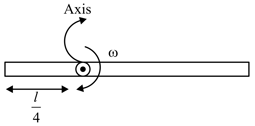Combined Rotational and Translational Motion
Combined Rotational and Translational Motion: Overview
This topic covers concepts, such as, Translational Motion, Rotational Motion, Precession of Axis of Rotation & Analogy Between Linear Motion and Rotational Motion etc.
Important Questions on Combined Rotational and Translational Motion
A disc is spinning with an angular velocity about the axis of spin. The couple applied to the disc causing precession will be
In an automobile, if the vehicle makes a left turn, the gyroscopic torque
The rotor of a ship rotates in clockwise direction when viewed from the stern and the ship takes a left turn. The effect of the gyroscopic couple acting on it will be
A disc spinning on its axis at will undergo precession when a torque is applied about an axis normal to it at an angular speed, if mass moment of inertia of the disc is the -
Which one of the following motion include translational motion of the rigid body?
A body under translational motion is rigid if:
A solid sphere of radius is gently placed on a rough horizontal surface with an initial angular speed but no linear velocity. If the coefficient of friction is , then the time when the slipping will stop is
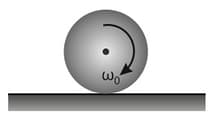
A spherical ball of mass is stationary at the top of hill of height . It rolls down a smooth surface to the ground, then climbs up another hill of height and finally rolls down to a horizontal base at a height of above the ground. The velocity attained by the ball is
A body rolls down an inclined plane. If its kinetic energy of rotation is of its kinetic energy of translation, then the body is
A round object of mass M and radius R rolls down without slipping along an inclined plane. The frictional force
A solid sphere rolls down without slipping on an inclined plane, then percentage of rotational kinetic energy of total energy will be
A uniform rod of length is free to rotate in a vertical plane about a fixed smooth hinge at one end. The rod is released from horizontal position as shown in the figure. When it has turned through angle its angular velocity is
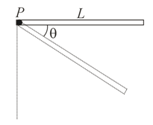
A thin uniform rod of length and mass suspended vertically is free to rotate about a smooth horizontal axis which passes through its end A. A point mass moving horizontally with velocity hits the lower end of the rod and sticks to it. After collision the rod just reaches the horizontal position. Which of the following statements is WRONG?
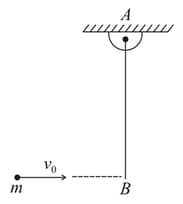
Moment of inertia of uniform horizontal solid cylinder of mass about an axis passing through its edge and perpendicular to the axis of the cylinder when its length is times its radius is
A uniform rod of length and mass is free to rotate about point . The rod is released from rest in the horizontal position. Given that the moment of inertia of the rod about is the initial angular acceleration of the rod will be :-
A uniform cylinder of radius is spun about its axis at an angular velocity and placed between two perpendicular walls. The coefficient of friction between the walls and cylinder is If this cylinder makes turns before it stops then find the value of .
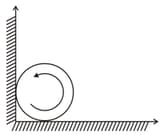
An object is performing uniform translatory motion. This implies:
A sphere of radius is moving in -axis with a velocity and rotates with angular speed as shown below. Assume then where will be the instantaneous axis of rotation ?
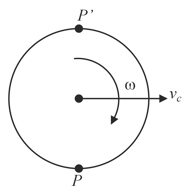
A particle of mass moving horizontally with a velocity collides and sticks to the bottom of the smoothly pivoted hanging rod of mass and length.
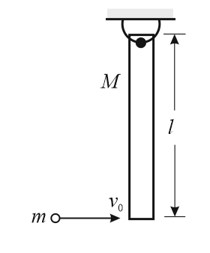
A uniform rod rotates in a vertical plane about the shown axis. Angular velocity at the moment is . Then, force on the rod by the axis at the moment
